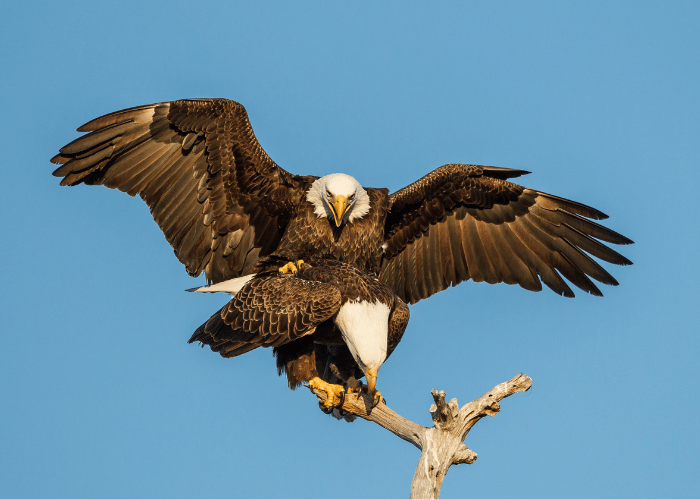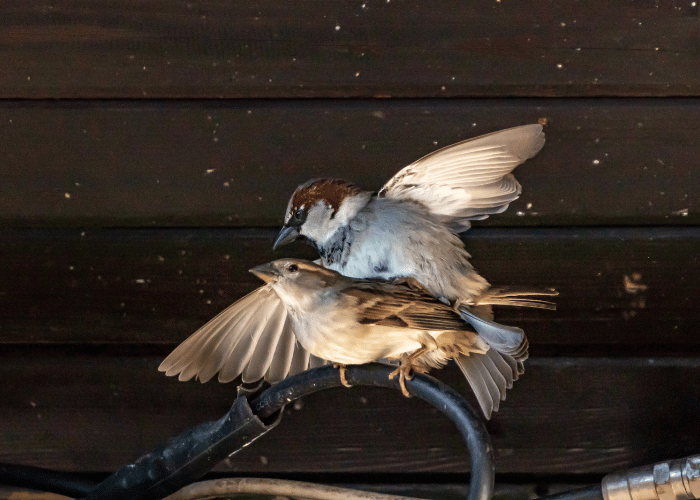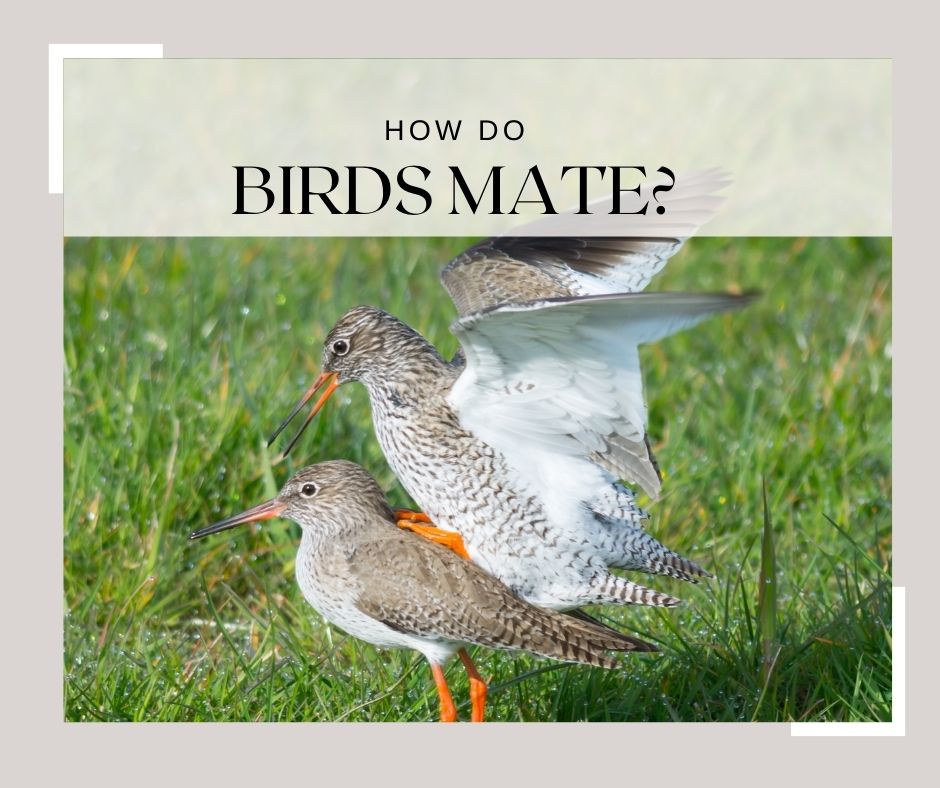How Do Birds Mate
Table of Contents
Ever pondered about the nitty-gritty of bird copulation? wondered about the hows and whats of these feathered friends’ mating rituals? Well, you’re not alone. The intricacies of avian reproduction are a source of fascination to many and believe me, it’s an intriguing rollercoaster ride in its own right.
So, let’s clarify one thing right away – birds mate much differently than mammals. Most birds don’t have a separate sexual organ per se; instead, both males and females have what’s known as a ‘cloaca’—an all-purpose exit and entrance for wastes and for the sperm and egg. Some might say it’s all very… efficient.
Yes, the ‘Cloacal Kiss’ as it’s often called, is perhaps one of the most unique and dare I say, quirky aspects of bird mating. But hey, make no mistake – there’s more to it than just the kiss. From elaborate courtship dances to beautiful love songs, your avian neighbors have got the art of wooing down to a science. What’s more, it’s all done with a healthy dose of style and flamboyance. Fascinating, isn’t it?

The Mysteries of Bird Reproduction
Nature’s way of ensuring survival can be fascinatingly complex, and there’s no better example than bird reproduction. Now, you might be wondering, how do birds mate? Well, it’s quite a story!
Most birds participate in a tricky little dance we call courting. You’ve probably seen males putting on bold, flamboyant displays, all in the hopes of catching a female’s eye. Yeah, that’s not them showing off for the fun of it. It’s all part of the mating game!
Once a female bird is sufficiently impressed, the actual act of bird mating can begin. Lots of birds are known as ‘cloacal kissers’. Here’s what it means: both males and females have an orifice known as a cloaca. During mating season, these cloacas swell, ready for action. When it’s game time, the male and female touch their cloacas together.
Transmission of sperm happens in a flash, often in under a second. Blink and you’ll miss it! It’s an efficient system, but it’s vital the timing is right.
Once the deed is done, it’s egg-laying time. The number of eggs laid varies significantly from species to species. Typically, smaller birds lay more eggs than larger ones. Here’s an interesting fact: birds like hummingbirds can lay up to 10 eggs, while larger birds such as eagles typically lay only one or two eggs at a time.
| Bird Type | Typical No. of Eggs |
|---|---|
| Hummingbirds | 5 – 10 |
| Eagles | 1 – 2 |
We can’t talk about bird reproduction without mentioning how daddies get involved too! Most bird fathers play a role, but it differs per species. Some guard the nest aggressively, others help build and maintain it. There are fathers who take turns incubating the eggs. Fatherhood in the bird world is pretty diverse!
When you look out your window and see a bird flutter by, there’s a whole lot of natural drama that they’re a part of. So next time you’re out bird watching or see a little feathered friend in your yard, remember how fascinating their basic act of reproduction really is. It’s more than just the birds and the bees!
Decoding the Birds’ Mating Rituals
So how do birds exactly mate, you wonder? Well, it’s not as straightforward as it may seem. First off, birds have a courtship period. This is the time when they charm each other with theatrics that can rival any Broadway show. Whether it’s flashy colors, majestic aerial displays or soulful serenades, it’s all about wooing that special bird.
Interestingly, birds use their senses fully during this process. And guess what? Their vision and hearing are often sharper than humans. So those intricate feather patterns and high-frequency songs that go unnoticed by us, well, they’re the main attractions in the bird world.
It gets even more fascinating. Ever heard about the ‘nuptial gift’ some birds present? Say you’re a male European Common Tern. In your world, it’s about showcasing your provider chops. So, you’ll catch a tasty fish, flaunt it to your love interest, and if she accepts, consider that her seal of approval.
Now, onto the actual deed. Unlike mammals, most birds don’t have separate reproductive organs. Instead, they have a single opening called the ‘cloaca’. When it’s time, both birds press their cloacas together in a ‘cloacal kiss’ and sperm is transferred. Quick and efficient, no frills. Sounds romantic?
Let’s put some numbers on the table. Here’s a simplified comparison for you:
| Characteristics | Birds | Mammals |
|---|---|---|
| Courtship | Highly Ritualized | Varies Widely |
| Sensory Use | Extensive vision and hearing | Predominantly smell |
| Mating Act | Cloacal Kiss | Physical Intercourse |
What about after mating? If you’re a bird, it’s not just a fly-off-into-the-sunset scenario. There’s the crucial nest-building, egg-laying, and the arduous, yet rewarding, process of raising the chicks. And that, my friend, is another tale for another day.
There we go! It’s obvious, isn’t it? Bird romance is fluttering feathers and lots of spectacle. It’s as intricate and diverse as the birds themselves. So, the next time you see a bird burst into a spontaneous aerial ballet, remember, you’re probably witnessing a grand love story unfold in the world of the feathers.

Intricacies of Bird Courtship Display
Bird courtship rituals are as diverse as the birds themselves. If you’ve ever been left in awe of a bird’s colorful display, or puzzled by their elaborate and sometimes peculiar dance, you’re observing bird courtship in action. Dancing, singing, nest building, and the display of vibrant plumage are all tactics to attract a mate.
Let’s dive into the world of bird courtship dances. As you may know, birds often perform intricate and unique dances. The male Greater Sage-Grouse, for example, inflates its chest into two large sacs, followed by an acoustic popping sound.
Now, imagine witnessing the Flamenco of the Avian world. The Red-capped Manakin impresses females with a rapid foot-shuffling routine, flapping its wings at high speed while sliding or moonwalking along a tree branch.
Of course, we can’t forget about the remarkable bowerbirds. They go to great lengths, constructing elaborate structures, known as “bowers”, to attract a mate. These aren’t mere nests a lot of intentions are poured into their design and decoration to wow potential mates.
- Satin Bowerbirds use sticks to build a structure, which they adorn with small bright blue objects.
- Vogelkop Bowerbirds create a sort of hut and decorate the “yard” with a variety of items, sometimes even creating a decorative “moss lawn”.
- Spotted Bowerbirds collect green and white items, arranging them from smallest to largest to create a perspective effect.
Singing or vocal displays are vital too. Often a male bird will have a distinct song or call, which serves as a signal to females of his species. This varies across different species with some songs being simple while others may be complex and lengthy.
Lastly, there’s the display of flashy feathers. Many male birds rely on this spectacle of color and pattern to woo their mates, like the dazzling Peacock and the vibrant Birds of Paradise.
Each display you see is a small glimpse into the intricate world of bird courtship behavior. A mesmerizing and complex wonder, that’s been shaped by evolution to ensure survival and continuation of their species.
How Birds Do the ‘Deed’: The Actual Mating Process
Let’s talk about the birds and the bees… or, more specifically, just the birds. Birds mate in many ways, but for the majority of species, it’s all over in seconds! Wondering why? Stick around and you’ll find out!
Not all birds are the same. Some are monogamous, choosing one partner for the duration of their lives, much like penguins or eagles. Others, like hummingbirds, are more of the “love ’em and leave ’em” type.
Here’s where it gets interesting. Bird anatomy! You see, both male and female birds have a cloaca — an opening birds use for excretion and reproduction. When it’s time to get down to business, birds will rub their cloacas together in what’s known as a “cloacal kiss”. How’s that for a romantic move?
For most bird species, mating season begins in the spring. You might notice that birds have started chirping a lot more, and that’s because they’re trying to attract a mate. In some species, males will put on a show to win over females with flashy displays and elaborate dances. Who doesn’t love a good dance-off?
This is where we come to the numbers. Here’s a quick markdown table to better visualize what goes down in the bird world.
| Bird Activity | Typical Duration |
|---|---|
| Mating display | A few minutes |
| Actual Mating | A few seconds |
Clearly, birds don’t like to beat around the bush when it comes to mating!
One last tidbit for you, bird eggs don’t come into the world just like that. It takes around 24 hours for an egg to form after mating. So, the next time you spot a nest teeming with tiny bird eggs, you’ll know just what a monumental task it’s been for the parents.
And voilà! Now, you’re a little bit more of a bird connoisseur. But remember, this is just an overview. Bird mating habits are fairly complex and can vary greatly from species to species. Aren’t birds wonderfully fascinating?!
The Miracle of Bird Eggs and Incubation
Have you ever wondered about the intricate process behind the creation of bird eggs and incubation? It’s truly a miracle to witness! Here’s a chance to peep behind the scenes of this remarkable natural event.
Birds lay eggs, just like many other creatures. The process starts when the female bird’s reproductive system produces an egg. The egg first exists as a yolk, where genes from the female exist. This is where things get interesting – when the male bird mates with the female, he transfers his genes to her and those are mixed with the yolk.
How?! You’d expect an intricate, complex process here but let me tell you, it’s quite simple and quick. Heck, they don’t even need to do any mating dance or elaborate rituals some species indulge in. Simple bird species just need the male to briefly climb onto the female’s back. (Pardon my pun, but it’s a birds-and-bees discussion after all!)
Moving onto the incubation, this is where your friend, the bird, turns into a dedicated parent. Post laying, birds start the incubation. The goal? To keep the eggs warm and ensure development of the chick inside.
Different bird species have varied incubation periods – these could be anywhere from 10 to 50 days. Want a quick look at some species and their approximate incubation periods? Let’s indulge you:
- House Sparrow: 10-14 days
- American Robin: 12-14 days
- Bald Eagle: 35 days
- Emperor Penguin: 64-67 days
To achieve uniform warmth, birds are known to rotate their eggs. The movement is often subtle, but it’s there. So, next time you are out bird-watching, be keen and you might just notice it!
Now, remember, the role of daddies isn’t just to chill post mating. Many bird species share the incubation process. Emperor penguins are a perfect example – they brave the harsh Antarctic winter, without food, all to keep their unborn chick warm. Talk about dedication!
That’s your crash course in the marvelous story behind bird eggs and incubation. Isn’t Mother Nature awe-inspiring? No wonder you’re always so fascinated with your feathered friends!

Wrapping It Up: The Wonders of Bird Mating
We’ve journeyed together through the seemingly odd, yet fascinating world of bird mating. You’ve discovered how intricately different it can be from one species to another. From elegant courtship dances to gallant nests, birds go to extraordinary lengths to attract their mates. You’ve seen that it’s not always about the brightest feathers or the largest nests. Sometimes, it’s the quiet persistence or the nurturing presence that wins the heart… or should we say, the beak!
Now, let’s summarize what we’ve learned:
- Birds typically have a mating season which corresponds to when they can find the most food.
- Specific mating rituals vary wildly between species – it could be dancing, singing, or building houses.
- Not all birds mate for life. Some choose a different partner each season, others stick together ’til the end.
By learning more about birds, you’ve been reminded of the dazzling diversity of nature. Every fluttering wing and chirping cry is a testament to the struggles and triumphs of life.
So next time you spot a couple of birds singing in your backyard or you see a bird in flight, you’ll remember the incredible processes involved. Little did we know, there’s a vast, complicated world taking place above us, as birds chirp, flutter, and go about their impressive lives.
There you have it – a whirlwind tour of the eccentricities of bird mating! So remember, love, even in bird language, is a universal conversation – and it’s happening all around us! There’s so much of it that goes without being noticed. But now, you’ll definitely appreciate these charming creatures with an entirely different lens!






